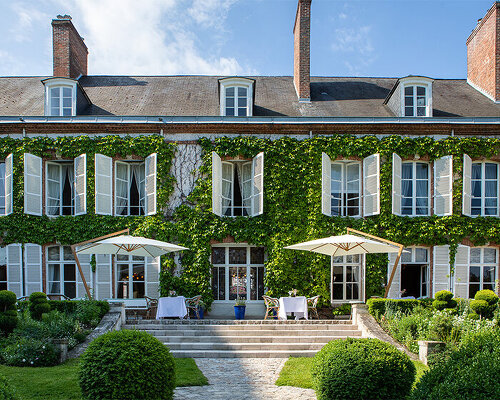a glimpse INSIDE Perrier-Jouët’s Maison Belle Époque
Nestled in the heart of Épernay, Champagne, Perrier-Jouët’s Maison Belle Époque opens its doors only to a rare few. Within its walls, more than two centuries of savoir-faire in champagne-making meet Europe’s largest private collection of Art Nouveau masterpieces — over 200 works by Gallé, Majorelle, Guimard, and their contemporaries — each reflecting the Maison’s enduring devotion to beauty and nature. Beneath the residence, three underground levels extend into the chalky soil, preserving thousands of bottles in various stages of fermentation, quietly connecting the art above to the craft below.
On the occasion of the Maison’s ongoing collaboration with Design Miami.Paris and its 2025 activations (find more in our Paris guide here), designboom was granted exclusive access to this historic residence, where Art Nouveau’s sinuous forms intertwine with contemporary commissions by today’s leading designers and artists, continuing Perrier-Jouët’s living conversation between art and design. Read on to explore the historic venue, the identity of the Maison, its connection to design and art, and its close relationship with the Design Miami fair.
all images courtesy of Perrier-Jouët, unless stated otherwise
A Heritage Steeped in Art Nouveau
Built in the late 18th century, La Maison Belle Époque captures the Perrier-Jouët spirit, where art and nature meet in a constant, creative exchange. The story began in 1811, when Pierre-Nicolas Perrier and Rose-Adélaïde Jouët combined their shared passions for winemaking, botany, and the arts to found the iconic champagne house. That same vision still resonates through the Belle Époque home in Épernay, where the largest private collection of Art Nouveau in Europe unfolds like a living gallery. Inside, visitors encounter unexpected treasures: an original Toulouse-Lautrec painting, a whimsical mushroom-shaped door by Hector Guimard echoing the organic entrances of the Paris Métro, and a room devoted to glassmaker Emile Gallé, whose delicate creations first gave visual form to the Maison’s signature floral identity. Throughout, Japanese influences appear in subtle references to the Japanese anemone, the flower that became Perrier-Jouët’s emblem, alongside furniture adorned with sculpted insects, carved vines, and blossoms that seem to grow naturally from the materials themselves. A bronze sculpture by Auguste Rodin, gifted by employees for the Maison’s centenary, adds a quietly human note.
Perrier-Jouët’s Maison Belle Époque opens its doors only to a rare few
Contemporary pieces Inside the Maison
Alongside its historic pieces, the Maison also houses a striking collection of contemporary works commissioned over the years by Perrier-Jouët from artists around the world. In the hallway, the kinetic table Ephemerā by mischer’traxler unfolds a delicate landscape of vibrantly colored metal plants and insects representing species that are current, extinct, or rediscovered. From a distance, the intricate garden seems to sway to its own rhythm, yet as a visitor approaches, the plants sense the presence and retreat, folding gracefully back into the surface. The work becomes a living metaphor for the fragile dialogue between humans and nature. First presented at Design Miami 2014, the piece now finds a permanent home within the Maison, embodying Perrier-Jouët’s vision of art as an evolving ecosystem.
Above the Maison Belle Époque bar, a luminous installation by glass artist Ritsue Mishima catches the eye. Titled All’ombra della luce (In the Shadow of Light), the work was first unveiled at Design Miami 2015. Here, light and shadow are the two protagonists: light evokes the rhythm of the vineyards and the bloom of summer in the Maison’s garden, while shadow recalls the stillness of the cellars where champagne quietly comes to life. Hundreds of suspended glass disks reinterpret Perrier-Jouët’s signature anemone motif. Each unique piece refracts halos of light and soft ripples, creating a suspended, dreamlike choreography that transforms the room into an inverted garden of glass and glow.
the Ephemerā kinetic table by mischer’traxler
Perrier-Jouët & design miami present the Design for Nature Award
Building on a partnership that began in 2012, Perrier-Jouët and Design Miami have once again joined forces to celebrate the intersection of art, design, and nature in the French capital. For the 2025 edition, the collaboration took over the legendary Maxim’s restaurant in Paris, transforming it into La Parenthèse Belle Époque, an immersive installation that reimagined the venue’s storied interiors through the lens of Perrier-Jouët’s heritage. Stained glass and arches adorned with Émile Gallé’s signature anemones framed vintage decorative objects and archival posters, creating a vibrant dialogue between Art Nouveau and contemporary design.
It was within this evocative setting that Perrier-Jouët and Design Miami presented the inaugural Perrier-Jouët Design for Nature Award. The new initiative invites designers to explore sustainability as a catalyst for cultural and environmental progress. Each year, the award will honor a designer whose practice embodies both a responsible approach to materials and production and a creative spirit aligned with the ethos of Art Nouveau. The selected designer will be commissioned to create a unique work to be unveiled at Design Miami the following year.
the largest private collection of Art Nouveau in Europe unfolds like a living gallery
image © designboom
image © designboom
image © designboom
image © designboom
The post in maison belle époque, perrier-jouët houses europe’s largest private art nouveau collection appeared first on designboom | architecture & design magazine.

